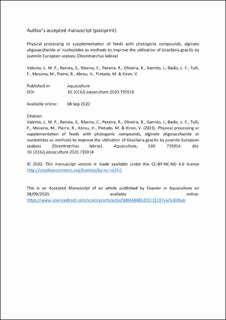| dc.contributor.author | Valente, Luisa M.P. | |
| dc.contributor.author | Batista, Sonia | |
| dc.contributor.author | Ribeiro, Catarina | |
| dc.contributor.author | Pereira, Ricardo | |
| dc.contributor.author | Oliveira, Beatriz | |
| dc.contributor.author | Garrido, Inês | |
| dc.contributor.author | Baião, Luís F. | |
| dc.contributor.author | Tulli, Francesa | |
| dc.contributor.author | Messina, Maria | |
| dc.contributor.author | Pierre, Ronan | |
| dc.contributor.author | Abreu, Helena | |
| dc.contributor.author | Pintado, Manuela | |
| dc.contributor.author | Kiron, Viswanath | |
| dc.date.accessioned | 2021-02-26T08:45:39Z | |
| dc.date.available | 2021-02-26T08:45:39Z | |
| dc.date.created | 2021-02-18T15:17:36Z | |
| dc.date.issued | 2020 | |
| dc.identifier.citation | Valente, L. M. P., Batista, S., Ribeiro, C., Pereira, R., Oliveira, B., Garrido, I., Baião, L. F., Tulli, F., Messina, M., Pierre, R., Abreu, H., Pintado, M. & Kiron, V. (2021). Physical processing or supplementation of feeds with phytogenic compounds, alginate oligosaccharide or nucleotides as methods to improve the utilization of Gracilaria gracilis by juvenile European seabass (Dicentrarchus labrax). Aquaculture, 530: 735914. doi: | en_US |
| dc.identifier.issn | 1873-5622 | |
| dc.identifier.uri | https://hdl.handle.net/11250/2730555 | |
| dc.description | Author's accepted version (postprint). | en_US |
| dc.description | This is an Accepted Manuscript of an article published by Elsevier in Aquaculture on 08/09/2020. | |
| dc.description | Available online: https://www.sciencedirect.com/science/article/pii/S0044848620313119?via%3Dihub | |
| dc.description.abstract | This study assessed both the effectiveness of a physical-mechanical rupture method and the ability of feed additives (phytogenic compounds, alginate oligosaccharide and nucleotides) to enhance the utilization of G. gracilis by European seabass. A commercial-based diet was used as control diet (CTRL) and compared with five isoproteic (53.5% Dry matter, DM) and isolipidic (14.9% DM) diets containing 8% of G. gracilis. This seaweed was either unprocessed (diet GRA) or subjected to physical processing (diet GRAP). The three additive-containing diets were formulated by supplementing the GRA diet with either 0.02% phytogenic compounds (PHY), 2.5% oligo-alginate (OAS) or 0.08% free nucleotides (NUC). Triplicate groups of nineteen fish (29.7 ± 0.02 g) were distributed by 50 L tanks (11.3 kg m−3) and fed the experimental diets to satiety during 106 days. By the end of the trial, growth performance and nutrient utilization (specific growth ratio, feed conversion ratio, apparent digestibility coefficients, nutrient balance, intestinal brush border membrane enzyme activities and plasma metabolic parameters), gut histomorphology, antioxidant and immunological status of fish were evaluated. The ability of fish to digest seaweed-rich diets was largely improved by the technological processing of G. gracilis, albeit nil effect on fish specific growth rate (1.0 in all groups). This major achievement was associated with increased ability of GRAP to digest protein (84 vs 68% in GRA) and energy (64 vs 38% in GRA). The use of feed additives in Gracilaria-rich diets was less efficacious in improving European sea bass nutrient and energy ADCs, but have still improved the overall digestibility of those diets. Fish fed alginate oligosaccharide was mainly associated with increased activity of anterior intestine enzymes, particularly intestinal alkaline phosphatase (IAP; 174.4 vs 104.7–120.6 μm min−1 g−1 in Gracilaria-rich diets). Moreover, the algae technological processing and both the nucleotides and the alginate oligosaccharide seem to have positively affected the intestinal villus width compared to the negative impact seen in fish fed GRA. The tested additives had limited impact on oxidative stress, although glutathione peroxidase (GPx; 2.1 μmol min−1 mg protein−1) and catalase (CAT; 35 μmol min−1 mg protein−1) activities were lowest in fish fed NUC and PHY, respectively. It can be concluded that the physical processing of Gracilaria sp. or the addition of either oligo-alginate or nucleotides can effectively increase the nutritional value of this seaweed for European seabass diets. | en_US |
| dc.language.iso | eng | en_US |
| dc.publisher | Elsevier | en_US |
| dc.rights | Attribution-NonCommercial-NoDerivatives 4.0 Internasjonal | * |
| dc.rights.uri | http://creativecommons.org/licenses/by-nc-nd/4.0/deed.no | * |
| dc.title | Physical processing or supplementation of feeds with phytogenic compounds, alginate oligosaccharide or nucleotides as methods to improve the utilization of Gracilaria gracilis by juvenile European seabass (Dicentrarchus labrax) | en_US |
| dc.type | Peer reviewed | en_US |
| dc.type | Journal article | en_US |
| dc.description.version | acceptedVersion | en_US |
| dc.subject.nsi | VDP::Landbruks- og Fiskerifag: 900::Fiskerifag: 920::Akvakultur: 922 | en_US |
| dc.source.pagenumber | 14 | en_US |
| dc.source.volume | 530 | en_US |
| dc.source.journal | Aquaculture | en_US |
| dc.identifier.doi | 10.1016/j.aquaculture.2020.735914 | |
| dc.identifier.cristin | 1891441 | |
| dc.source.articlenumber | 735914 | en_US |

